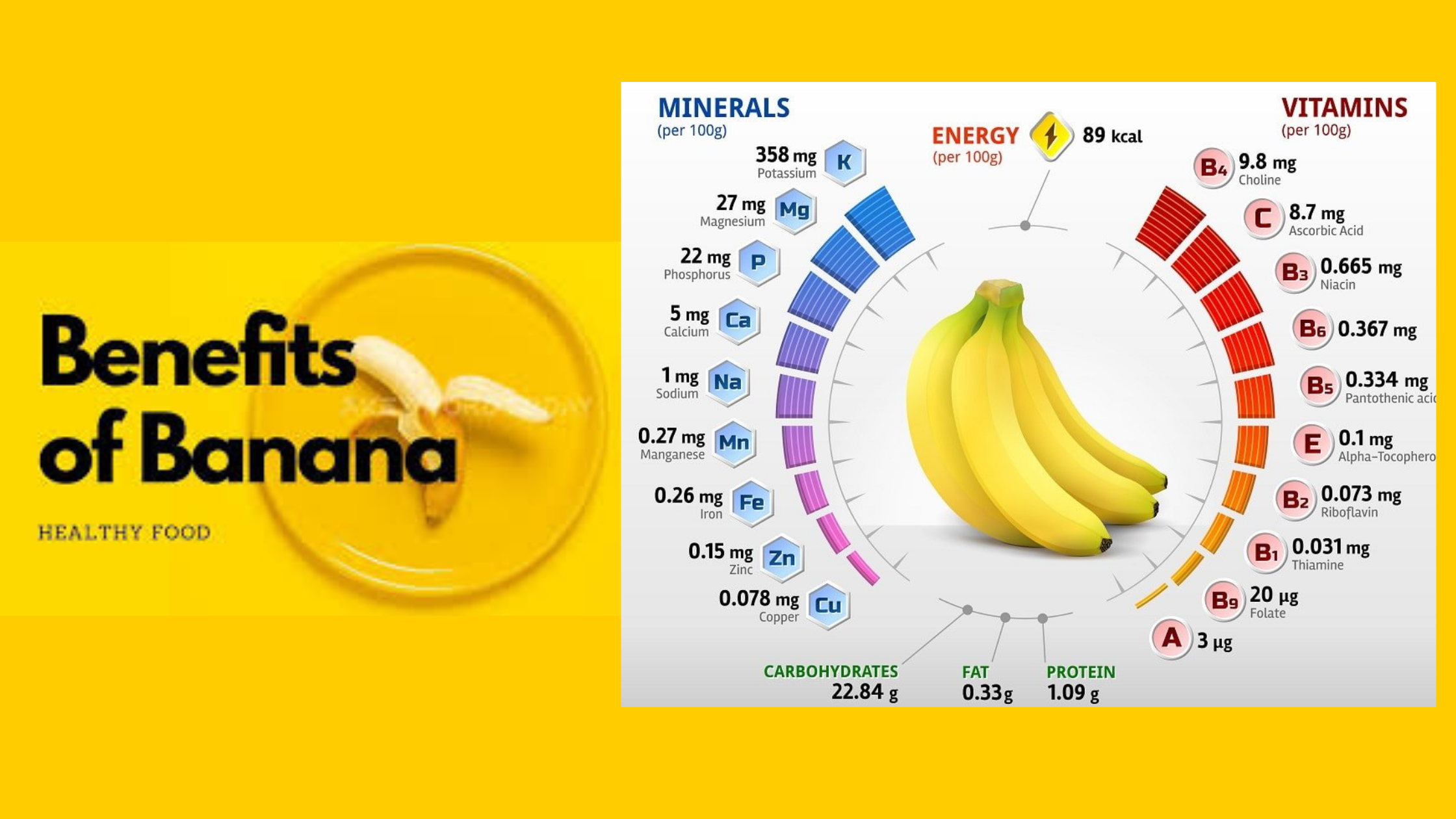
“The high level of vitamin B6 in bananas is known to reduce edema, defend against Type 2 diabetes, aid in weight reduction, improve the neurological system, and help in the formation of white blood cells,” Flores told Live Science.
Bananas are one of the most widely consumed fruits on the planet. They’re packed with essential nutrients, but eating too many might cause more damage than good. Excessive consumption of any one meal can lead to weight gain and nutritional deficiencies. For most healthy adults, one to two bananas per day is considered a moderate consumption.
When is it better to eat a banana?
Early in the morning
The ideal time to consume a banana is in the morning, especially when combined with other fruits/oatmeal, which can help those who are considering a weight loss program. Banana Oatmeal Cookies- This alternative is both nutritious and yummy, and it will help your body recharge.
Bananas Have 11 Proven Health Benefits
Bananas are both nutritious and tasty. They’re high in important nutrients and can help with digestion, heart health, and weight loss. They are also a very handy snack item, in addition to being incredibly healthy. Bananas have 11 scientifically proven health advantages.
1. Bananas Contain a Wide Range of Beneficial Nutrients
Bananas are one of the most popular fruits on the planet.
They originated in Southeast Asia and are now cultivated in many warm climates across the world.
Bananas come in a variety of colors, sizes, and shapes.
The Cavendish banana, a variety of dessert banana, is the most prevalent. It is green when unripe and becomes yellow as it ripens.
Bananas are high in fiber, as well as a number of antioxidants. 1 medium banana (118 grams) also contains the following nutrients (1, 2Trusted Source, 3Trusted Source):
Potassium: 9% of the recommended daily intake
33 percent of the RDI for vitamin B6
11 percent of the RDI for vitamin C
Magnesium: 8% of the recommended daily intake
Copper accounts for 10% of the RDI.
Manganese is at 14% of the RDI
24 grams of net carbohydrates
3.1 grams of fiber
1.3 grams of protein
0.4 gram fat
Each banana has just approximately 105 calories and is nearly entirely made up of water and carbohydrates. Bananas are low in protein and nearly fat-free.
Starch and resistant starch make up the majority of the carbohydrates in green, unripe bananas, but when the banana ripens, the starch transforms into sugar (glucose, fructose and sucrose).
2. Nutrients in bananas help to keep blood sugar levels in check.
Pectin, a kind of fiber found in bananas, is responsible for the flesh’s spongy structure (4).
Resistant starch, found in unripe bananas, works like soluble fiber and resists digestion.
By delaying the emptying of your stomach, both pectin and resistant starch may help to regulate blood sugar levels after meals and reduce hunger (5Trusted Source, 6Trusted Source, 7Trusted Source).
Bananas also have a low to the medium glycemic index (GI), which is a scale ranging from 0 to 100 that indicates how rapidly meals raise blood sugar levels.
Unripe bananas have a GI of around 30, whereas ripe bananas have a GI of around 60. All bananas have a worth of 51 cents on average (8, 9Trusted Source).
This indicates that in healthy people, bananas should not produce significant blood sugar increases.
People with type 2 diabetes, on the other hand, should definitely avoid eating a lot of well-ripened bananas and closely check their blood sugar if they do.
3. Bananas may help with digestion.
Many health advantages have been attributed to dietary fiber, including better digestion.
Bananas include around 3 grams of fiber per medium-sized banana, making them a healthy source of fiber (10Trusted Source).
Bananas are high in two kinds of fiber:
As the banana ripens, the pectin content decreases.
Unripe bananas contain resistant starch.
Resistant starch gets through your digestive system and ends up in your large intestine, where it feeds the good bacteria in your gut (11Trusted Source, 12Trusted Source, 13).
4. Bananas Could Help You Lose Weight
There has been no direct research into the benefits of bananas on weight loss. Bananas, on the other hand, contain a number of qualities that make them a good weight-loss meal.
Bananas, for starters, have a low calorie count. Although a banana has just over 100 calories, it is also extremely healthy and satisfying.
More fiber from vegetables and fruits like bananas has been related to reduced body weight and weight reduction on several occasions (16Trusted Source, 17Trusted Source, 18Trusted Source).
Furthermore, because unripe bananas are high in resistant starch, they are highly filling and may suppress your appetite (19Trusted Source, 20Trusted Source).
5. Bananas Could Help Your Heart
Potassium is a vital element for heart health, particularly blood pressure management.
Despite its significance, few people consume enough potassium (21).
Bananas are a good source of potassium in the diet. 9 percent of the RDI is found in one medium-sized banana (118 grams).
Potassium-rich foods can help decrease blood pressure, and potassium-rich persons have a 27 percent lower risk of heart disease (22Trusted Source, 23Trusted Source, 24Trusted Source, 25Trusted Source).
Bananas also contain a significant quantity of magnesium, which is beneficial to heart health (26Trusted Source, 27).
6. Bananas Are High in Antioxidants
Bananas are a good source of dietary antioxidants, as are other fruits and vegetables.
Dopamine and catechins are two types of powerful antioxidants found in them (1, 2Trusted Source).
Antioxidants have been linked to a variety of health advantages, including a lower risk of heart disease and degenerative diseases (28Trusted Source, 29Trusted Source).
Dopamine from bananas, on the other hand, does not penetrate the blood-brain barrier. Instead of affecting hormones or emotions, it merely works as a powerful antioxidant (2Trusted Source, 30Trusted Source).
However, it is a popular misconception that bananas contain dopamine, which is a feel-good neurotransmitter in the brain.
7. Bananas May Make You Feel Full Resistant starch is an indigestible carb
present in unripe bananas and other foods that work in your body like soluble fiber.
The higher the resistant starch concentration of a banana, the greener it is, as a rule of thumb (31).
Yellow, ripe bananas, on the other hand, have lower levels of resistant starch and total fiber, but greater levels of soluble fiber.
Pectin and resistant starch both suppress appetite and promote feelings of fullness after meals (20Trusted Source, 32Trusted Source, 33Trusted Source, 34Trusted Source).
8. Bananas that aren’t fully ripe may help with insulin sensitivity.
Insulin resistance, like type 2 diabetes, is a major risk factor for many of the world’s most severe illnesses.
Several studies show that eating 15–30 grams of resistant starch each day for four weeks can increase insulin sensitivity by 33–50 percent (35Trusted Source, 36Trusted Source).
Resistant starch is abundant in unripe bananas. As a result, they may aid in improving insulin sensitivity.
However, the cause of these effects is unknown, and not all research support this theory (35Trusted Source, 37Trusted Source).
9. Bananas Could Help Your Kidneys
Potassium is necessary for blood pressure regulation and renal health.
Bananas may be especially useful for kidney health since they are an excellent source of potassium in the diet.
Women who ate bananas 2–3 times a week were 33 percent less likely to develop kidney disease, according to a 13-year study (38Trusted Source).
According to other research, those who eat bananas 4–6 times a week had a nearly 50% lower risk of renal disease than those who don’t (38Trusted Source, 39Trusted Source).
10. Bananas Could Help With Exercise
Because of their mineral richness and readily digestible carbohydrates, bananas are frequently referred to be the ideal diet for athletes.
Bananas may aid in the reduction of exercise-related muscular cramps and discomfort, which affect up to 95% of the population (40Trusted Source).
The cause of the cramping is uncertain, although one hypothesis blames them on a combination of dehydration and electrolyte imbalance (41Trusted Source, 42Trusted Source, 43Trusted Source).
However, research on bananas and muscular cramps has had conflicting results. While some research show that they are beneficial, others show that they have no impact (44Trusted Source).
Bananas, on the other hand, are a good source of nourishment before, during, and after endurance activity (45Trusted Source).
11. Bananas Are Simple to Include in Your Diet
Bananas are not only nutritious, but they’re also one of the most handy snack foods available.
Yogurt, cereal, and smoothies all benefit from the inclusion of bananas. You may also substitute them for sugar in baking and cooking.
Furthermore, due to their thick protective skin, bananas seldom contain pesticides or contaminants.
Bananas are quite simple to consume and transport. They’re typically well accepted and digestible; all you have to do is peel and consume them.
It doesn’t get much more straightforward than that.




